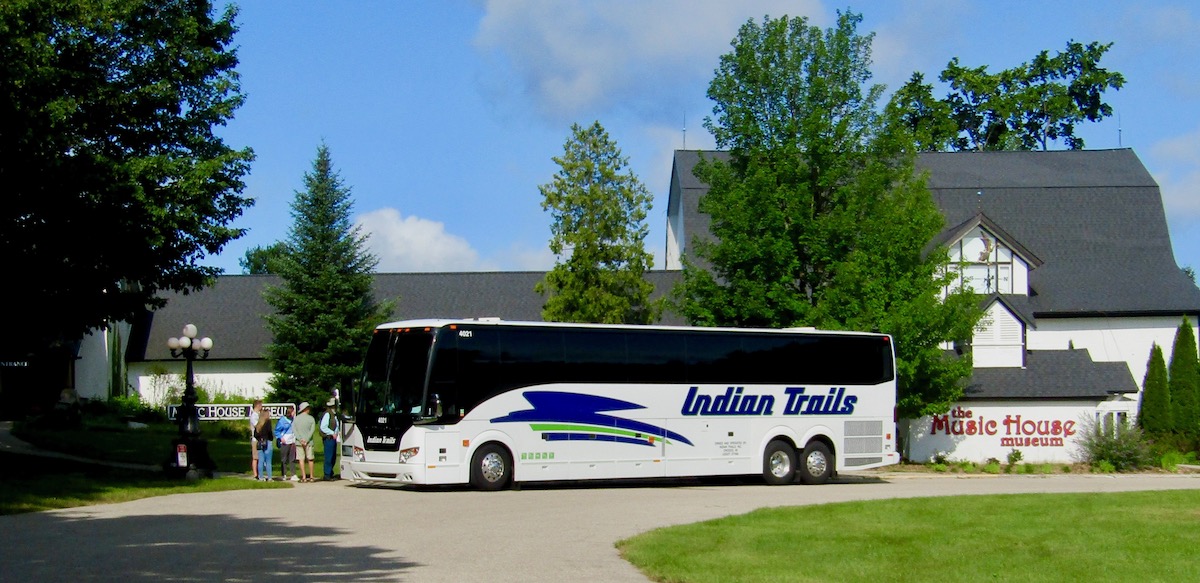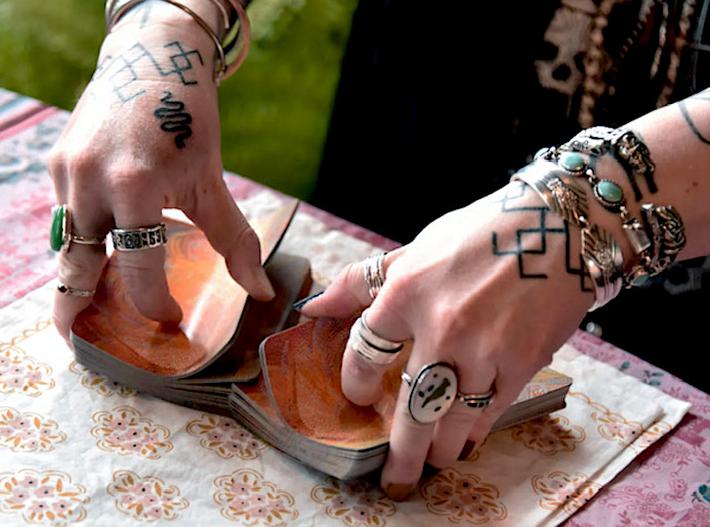
A Little Music History Lesson
A tour of Williamsburg’s Music House Museum
By Al Parker | Aug. 5, 2023
The sun is shining and a pair of aerobatic birds dance through the azure sky as I drive into the circular drive of the Music House Museum.
There’s a tour bus out front, and it’s loading visitors who have finished their morning stop at the museum. There’s a buzz about the tour they've just finished. “I’m just really impressed by those instruments and that they all work,” one tells her companion. “And it’s here in Michigan!”
I’m finally getting a chance to explore a landmark I’ve literally passed by hundreds of times during my years of chasing stories in northern Michigan.
The Magic of the Music Box
The Music House Museum sits right on busy US-31 between Traverse City and Elk Rapids. I feel a slight twinge of guilt for not visiting sooner. But guilt vanishes when I’m greeted warmly by Executive Director Tim Keaton and Events Coordinator Becky Gagnon.
Gagnon is very, very knowledgeable and takes the lead of our tour that’s part musical memories, part history lesson. Some 500,000 visitors have taken these tours since the Music House Museum was opened in 1983, but I’ll bet not many have tried scribbling down notes and lugging a camera at the same time as absorbing all the musical history Gagnon is eager to share.
Early in the tour we see Edison phonographs, an assortment of early radios, and even a large wooden dog, Nipper—the trademark of RCA Victor’s ads of “His Master’s Voice.” Radio Corporation of America, which was founded in 1919 and went defunct in 1987, helped bring us the National Broadcasting Company (aka NBC), radio receiver phonographs, and black-and-white and color television.
But it’s the music boxes that catch my eye.
“These are the disc music boxes,” explains Gagnon as we visit The Acme General Store, which houses several large music boxes, including a pair of impressive Regina instruments, dating back to the 1890s.
Regina music boxes were popular throughout the late 1800s and the first two decades of the 1900s. The boxes use a flat metal disc, as opposed to a cylinder disc, and customers could buy new discs with new music for their boxes. Sizes ranged from 8.5 to a whopping 27 inches. Every model was known for its rich tone. The company’s 15.5-inch model was the most popular music box made in the U.S. and sold for $65 when it was new in 1896. (That’s about $2,100 today.)
“I'm amazed by the ingenuity of these people to make music and to keep it in their homes,” says Keaton, a self-taught guitarist whose own musical background includes a stint as a vocalist at Michigan State University.
“Regina built 90 percent of all disc music boxes owned in the United States,” adds Gagnon.
Between 1892 and 1921, Regina shipped 100,000 music boxes. The bustling company had 325 employees and thrived as a market leader. But competition from the phonograph jeopardized the company, and in 1902 it dropped “Music Box” from its name and started to diversify, making vacuum cleaners. Eventually, Regina went bankrupt in 1922.
Miniatures, Saloons, and Gershwin
As the tour continues, I get to visit an old friend.
I first encountered Traverse City’s Miniature City when my family took a northern Michigan vacation back in the 1950s. It was displayed from 1931 to the early 1970s in Clinch Park and was donated to the Museum in 1991. Because of its poor condition, only a few original buildings were repairable, so local artisans began recreating the display. Some two dozen buildings—mostly on Front Street—are here on display.
Gagnon leads us next to a reproduction of TC’s turn-of-the-century Hurry Back Saloon, a Front Street watering hole that was popular in its heyday. Instead of lumberjacks, this version of the Hurry Back houses the museum’s player pianos—11 of them, in fact.
The Saloon is also home to a nickelodeon that features a continuous 350-foot loop of perforated paper to play musical selections.
Our next stop is at what looks, to my untrained eye, like an over-the-top elaborate piano.
“This is a 1925 Weber Duo Art Reproducing Piano,” explains Gagnon. “It was owned by the Fisher family, of the Fisher auto family.”
Reproducing pianos offer the effect of authentically copying a live performance, in this case, the musical genius George Gershwin himself playing his historic “Rhapsody in Blue.”
I was mesmerized by the five-minute version of this American classic. I’m no musical expert, but over the years I’ve heard plenty of versions of Gershwin’s landmark tune, and I never felt the dynamic range, power, and drama of the piece until hearing it at the Music House Museum.
In researching "Rhapsody in Blue," I learned that in 1924 Gershwin originally declined to write the piece for bandleader Paul Whitman. Gershwin simply didn’t have time to meet Whitman’s deadline, but after some persuasion Gershwin reluctantly agreed.
With only five weeks until the concert, Gershwin hurriedly set about composing the work. In a 1931 biography by Isaac Goldberg, Gershwin explained how a train trip to Boston inspired him.
“It was on the train, with its steely rhythms, its rattle-ly bang, that is so often so stimulating to a composer,” said Gershwin. “I frequently hear music in the very heart of the noise. And there I suddenly heard—and even saw on paper—the complete construction of the rhapsody, from beginning to end.”
The Jewel of the Museum
Next we check out a beautiful 1924 Wurlitzer organ, formerly of Detroit’s Cinderella Theatre. This impressive instrument features 1,000 pipes and over a dozen other musical devices like gongs, bells, and sleigh bells.
Finally, up a flight of stairs, we visit the crown jewel of the museum: the 1922 Theofiel Mortier Dance Organ called “The Amaryllis.” It was named by the builder for the flower in his daughter’s hair, pictured in the top of the huge instrument.
Originally built for a dance hall in Belgium, the organ is massive. Crafted out of durable lime wood, it measures 32 feet wide and 18 feet tall. It’s one of the few that survived World War II and was brought to the U.S. in 1967, then bought by the museum from Ohio collectors in 1982.
“The company built about 1,400 of them, and only 30 authentic organs remain, mostly in private collections,” explains Gagnon. “Many were chopped up and used for firewood. This is number 998 made by the company.”
The Amaryllis is one of only two such organs with its original casework and paint, which is cleaned regularly by the Verbeek family who come from Antwerp, Belgium, to lovingly care for this historic gem.
“Would you like to hear it?” asks Gagnon.
“Absolutely.”
She walks behind the organ, and in less than a minute, we’re hearing the upbeat “12th Street Rag” in a tsunami of sound. The instrument plays hundreds of tunes, ranging from this 1927 ragtime hit popularized by Louis Armstrong to “Bohemian Rhapsody” by Queen.
A Bit of History
Thus ended the tour, but now I wanted to learn more about the Music House Museum. How did this haven for historical music makers end up near Traverse City?
The museum sits on property that was the Sittler family farm, cleared and settled in the early 1880s. The farm’s former dairy barn houses the main collections, while the granary serves as the museum’s front entrance.
In 1979, David Stiffler, a well-known area architect, and Dean Junker formed D and D Enterprises to collect, restore, and display mechanical instruments. For three years, they worked to refurbish the 1909 barn and the granary, which doubled as living quarters for the farm’s hired hands and was referred to as the “old house.” (That’s how the museum got its name, as the old house is now filled with music.)
The museum debuted on a limited basis in 1983. The entire display was opened a year later and has grown ever since. Like any self-respecting museum, the Music House has a gift shop with a variety of fine gifts for music lovers. Its proceeds are an important part of the operations revenue flow.
Keaton says the heartbeat of the Music House Museum’s operation is its battalion of dedicated volunteers and generous donors.
“I really like working with the volunteers,” he tells me. “We have about 30 volunteers and about 10 who are very active. It’s really gratifying. And we always need volunteers. If anyone's interested, send us an email.”
The museum hosts numerous concerts and events throughout the season, including its Silent Film Series, with one coming up on Aug. 18; a Collectibles sale Sept. 1-2; a Pizza and Pipes program later this year; and a School Day Program that routinely hosts some 300 youngsters a year from 20 different northern Michigan schools. Head to musichouse.org for details.
Trending

Meaningful, Practical, Magical
Sarah Snider, owner of Poetess and Stranger, has poured nearly three decades of experience into the creation of her Petosk... Read More >>
Restoring Sleeping Bear Inn
It won’t be long before Glen Haven visitors will be able to experience waking up in the oldest hotel in the National... Read More >>
GTB Celebrating 44 Years
The Grand Traverse Band of Ottawa and Chippewa Indians will host their 44th Annual Federal Recognition Day – Mini Tr... Read More >>


